Facile Synthesis of Ultra-Small Silver Nanoparticles Stabilized on Carbon Nanospheres for the Etherification of Silanes
Abstract
:1. Introduction
2. Materials and Methods
2.1. Chemicals
2.2. Preparation of Ag/C Catalysts
2.3. Si–O Coupling Reaction
2.4. Kinetic Resolution through Si–O Coupling
2.5. Characterization
3. Results and Discussion
4. Conclusions
Supplementary Materials
Author Contributions
Funding
Data Availability Statement
Conflicts of Interest
References
- Anbu, N.; Dhakshinamoorthy, A. Cu3(BTC)2 catalyzed dehydrogenative coupling of dimethylphenylsilane with phenol and homocoupling of dimethylphenylsilane to disiloxane. J. Colloid Interface Sci. 2017, 490, 430–435. [Google Scholar] [CrossRef]
- Cardoso, J.M.S.; Lopes, R.; Royo, B. Dehydrogenative silylation of alcohols catalysed by half-sandwich iron N-heterocyclic carbene complexes. J. Organomet. Chem. 2015, 775, 173–177. [Google Scholar] [CrossRef]
- Wu, S.; Su, T.; Liu, S.; Cheng, D.; Zeng, R.; Ma, X.; Liang, S.; Ding, S.; Chen, C. Charge modifed porous organic polymer stabilized ultrasmall Platinum nanoparticles for the catalytic dehydrogenative coupling of silanes with alcohols. Catal. Lett. 2022, 152, 1711–1718. [Google Scholar] [CrossRef]
- Negrete, J.M.L.; Putaux, J.-L.; David, L.; Bourgeat-Lami, E. Aqueous dispersions of silane-functionalized laponite clay platelets. A first step toward the elaboration of water-based polymer/clay nanocomposites. Langmuir 2004, 20, 1564–1571. [Google Scholar] [CrossRef]
- Szafoni, E.; Kuciński, K.; Hreczycho, G. Cobalt-catalyzed synthesis of silyl ethers via cross-dehydrogenative coupling between alcohols and hydrosilanes. Green Chem. Lett. Rev. 2022, 15, 757–764. [Google Scholar] [CrossRef]
- Kuciński, K.; Hreczycho, G. Highly effective route to Si–O–Si moieties via O-silylation of silanols and POSS silanols with disilazanes: New tricks for an old dog. ChemSusChem 2019, 12, 1043–1048. [Google Scholar] [CrossRef]
- Kuciński, K.; Gruszczyński, M.; Hreczycho, G. Ru-catalyzed formation of thiosilanes and selenosilanes using dichalcogenides as a user-friendly alternative to thiols and selenols. ChemCatChem 2022, 14, e202200961. [Google Scholar] [CrossRef]
- Kuciński, K.; Hreczycho, G. Silicon–nitrogen bond formation via dealkynative coupling of amines with bis(trimethylsilyl)acetylene mediated by KHMDS. Chem. Commun. 2022, 58, 11386–11389. [Google Scholar] [CrossRef]
- Gao, H.; Battley, A.; Leitao, E.M. The ultimate Lewis acid catalyst: Using tris(pentafluorophenyl) borane to create bespoke siloxane architectures. Chem. Commun. 2022, 58, 7451–7465. [Google Scholar] [CrossRef]
- Dong, X.; Kita, Y.; Oestreich, M. Kinetic resolution of α-hydroxy-substituted oxime ethers by enantioselective Cu–H-catalyzed Si–O coupling. Angew. Chem. Int. Ed. 2018, 57, 10728–10731. [Google Scholar] [CrossRef]
- Hill, M.S.; Morris, L.J.; Mahon, M.F.; Manners, I.; McMenamy, F.; Whittell, G.R. Heavier alkaline–earth catalyzed dehydrocoupling of silanes and alcohols for the synthesis of metallo–polysilylethers. Chem. Eur. J. 2020, 26, 2954–2966. [Google Scholar]
- Farcaş-Johnson, M.A.; Kyne, S.H.; Webster, R.L. Dehydrocoupling polymerization: Poly(silylether) synthesis by using an Iron β-diketiminate catalyst. Chem.Eur. J. 2022, 28, e202201642. [Google Scholar] [CrossRef] [PubMed]
- Gasperini, D.; King, A.K.; Coles, N.T.; Mahon, M.F.; Webster, R.L. Seeking heteroatom-rich compounds: Synthetic and mechanistic studies into Iron catalyzed dehydrocoupling of silanes. ACS Catal. 2020, 10, 6102–6112. [Google Scholar] [CrossRef]
- Mirela, A.F.; Gasperini, D.; Andrew, K.K.; Sakshi, M.; Barrett, A.N.; Lau, S.; Mary, F.M.; Sara, H.K.; Ruth, L. Webster. Iron(II)-catalyzed activation of Si–N and Si–O bonds using hydroboranes. Organometallics 2023, 42, 3013–3024. [Google Scholar]
- Mukherjee, D.; Thompson, R.R.; Ellern, A.; Sadow, A.D. Coordinatively saturated tris(oxazolinyl)borato zinc hydride-catalyzed cross dehydrocoupling of silanes and alcohols. ACS Catal. 2011, 1, 698–702. [Google Scholar] [CrossRef]
- Satoh, Y.; Igarashi, M.; Sato, K.; Shimada, S. Highly selective synthesis of hydrosiloxanes by Au-catalyzed dehydrogenative cross-coupling reaction of silanols with hydrosilanes. ACS Catal. 2017, 7, 1836–1840. [Google Scholar] [CrossRef]
- Peterson, E.; Khalimon, A.Y.; Simionescu, R.; Kuzmina, L.G.; Howard, J.A.K.; Nikonov, G.I. Diversity of catalysis by an imido- hydrido complex of molybdenum mechanism of carbonyl hydro-silylation and silane alcoholysis. J. Am. Chem. Soc. 2009, 131, 908–909. [Google Scholar] [CrossRef] [PubMed]
- Toutov, A.A.; Betz, K.N.; Haibach, M.C.; Romine, A.M.; Grubbs, R.H. Sodium hydroxide catalyzed dehydrocoupling of alcohols with hydrosilanes. Org. Lett. 2016, 18, 5776–5779. [Google Scholar] [CrossRef] [PubMed]
- Voronova, E.D.; Golub, I.E.; Pavlov, A.; Belkova, N.V.; Filippov, O.A.; Epstein, L.M.; Shubina, E.S. Dichotomous Si–H bond activation by alkoxide and alcohol in base-catalyzed dehydrocoupling of silanes. Inorg. Chem. 2020, 59, 12240–12251. [Google Scholar] [CrossRef]
- Even, D.; Berkland, C. Selectivity of dehydrogenative silicone–oxygen bond formation in diphenylsilane by base and base-activated catalysts. Int. J. Chem. Kin. 2022, 54, 478–487. [Google Scholar] [CrossRef]
- Gonzalez-Fernandez, R.; Crochet, P.; Cadierno, V. Half-sandwich ruthenium(II) complexes with tethered arene-phosphinite ligands: Synthesis, structure and application in catalytic cross dehydrogenative coupling reactions of silanes and alcohols. Dalton Trans. 2020, 49, 210–222. [Google Scholar] [CrossRef] [PubMed]
- Ventura-Espinosa, D.; Carretero-Cerdán, A.; Baya, M.; García, H.A.; Mata, J. Catalytic dehydrogenative coupling of hydrosilanes with alcohols for the production of hydrogen on-demand: Application of a silane/alcohol pair as a liquid organic hydrogen carrier. Chem. Eur. J. 2017, 23, 10815–10821. [Google Scholar] [CrossRef] [PubMed]
- Lv, H.; Laishram, R.D.; Chen, J.; Khan, R.; Zhu, Y.; Wu, S.; Zhang, J.; Liu, X.; Fan, B. Photocatalyzed cross-dehydrogenative coupling of silanes with alcohols and water. Chem. Commun. 2021, 57, 3660–3663. [Google Scholar] [CrossRef]
- Kuciński, K.; Stachowiak-Dłużyńska, H.; Hreczycho, G. Catalytic silylation of O–nucleophiles via Si–H or Si–C bond cleavage: A route to silyl ethers, silanols and siloxanes. Coord. Chem. Rev. 2022, 459, 214456. [Google Scholar] [CrossRef]
- Purkayshtha, A.; Baruah, J.B. Some aspects of copper and silver colloids in silane activation. React. Funct. Polym. 2005, 63, 177–183. [Google Scholar] [CrossRef]
- White, R.J.; Luque, R.; Budarin, V.L.; Clark, J.H.; Macquarrie, D.J. Supported metal nanoparticles on porous materials methods and applications. Chem. Soc. Rev. 2009, 38, 481–494. [Google Scholar] [CrossRef] [PubMed]
- Stratakis, M.; Garcia, H. Catalysis by supported gold nanoparticles: Beyond aerobic oxidative processes. Chem. Rev. 2012, 112, 4469–4506. [Google Scholar] [CrossRef]
- Burda, C.; Chen, X.; Narayanan, R.; El-Sayed, M.A. Chemistry and properties of nanocrystals of different shapes. Chem. Rev. 2005, 105, 1025–1102. [Google Scholar] [CrossRef]
- Zhu, Y.P.; Liu, Y.P.; Yuan, Z.Y. Biochemistry-inspired direct synthesis of nitrogen and phosphorus dual-doped microporous carbon spheres for enhanced electrocatalysis. Chem. Commun. 2016, 52, 2118–2121. [Google Scholar] [CrossRef]
- Gao, S.; Wei, X.; Liu, H.; Geng, K.; Wang, H.; Moehwald, H.; Shchukin, D. Transformation of worst weed into N-, S-, and P-tridoped carbon nanorings as metal-free electrocatalysts for the oxygen reduction reaction. J. Mater. Chem. A 2015, 3, 23376–23384. [Google Scholar] [CrossRef]
- Sorribes, I.; Ventura-Espinosa, D.; Assis, M.; Martin, S.; Concepcion, P.; Bettini, J.; Longo, E.; Mata, J.A.; Andres, J. Unraveling a biomass-derived multiphase catalyst for the dehydrogenative coupling of silanes with alcohols under aerobic conditions. ACS Sustain. Chem. Eng. 2021, 9, 2912–2918. [Google Scholar] [CrossRef]
- Petrosko, S.H.; Johnson, R.; White, H.; Mirkin, C.A. Nanoreactors: Small Spaces, Big Implications in Chemistry. J. Am. Chem. Soc. 2016, 138, 7443–7445. [Google Scholar] [CrossRef] [PubMed]
- Wang, C.; Lin, X.; Ge, Y.; Shah, Z.H.; Lu, R. Silica-supported ultra small gold nanoparticles as nanoreactors for the etherification of silanes. RSC Adv. 2016, 6, 102102–102108. [Google Scholar] [CrossRef]
- Liu, M.; Liu, Y.; Gao, Z.; Wang, C.; Ye, W.; Lu, R.; Zhang, S. Nitrogen and sulfur co-doped carbon nanospheres for highly efficient oxidation of ethylbenzene. New J. Chem. 2018, 42, 15962–15967. [Google Scholar] [CrossRef]
- Thomas, A.; Lethuillier-Karl, L.; Nagarajan, K.; Vergauwe, R.M.A.; George, J.; Chervy, T.; Shalabney, A.; Devaux, E.; Genet, C.; Moran, J.; et al. Tilting a ground-state reactivity landscape by vibrational strong coupling. Science 2019, 363, 615–619. [Google Scholar] [CrossRef] [PubMed]
- Atkins, P. Atkins’ Physical Chemistry; Oxford University Press: Oxford, UK, 2006; pp. 796–797. [Google Scholar]
- Mitsudome, T.; Yamamoto, Y.; Noujima, A.; Mizugaki, T.; Jitsukawa, K.; Kaneda, K. Highly efficient etherification of silanes by using Gold nanoparticle catalyst: Remarkable effect of O2. Chem. Eur. J. 2013, 19, 14398–14402. [Google Scholar] [CrossRef] [PubMed]
- Dhakshinamoorthy, A.; Concepcion, P.; Garcia, H. Dehydrogenative coupling of silanes with alcohols catalyzed by Cu3(BTC)2. Chem. Commun. 2016, 52, 2725–2728. [Google Scholar] [CrossRef]
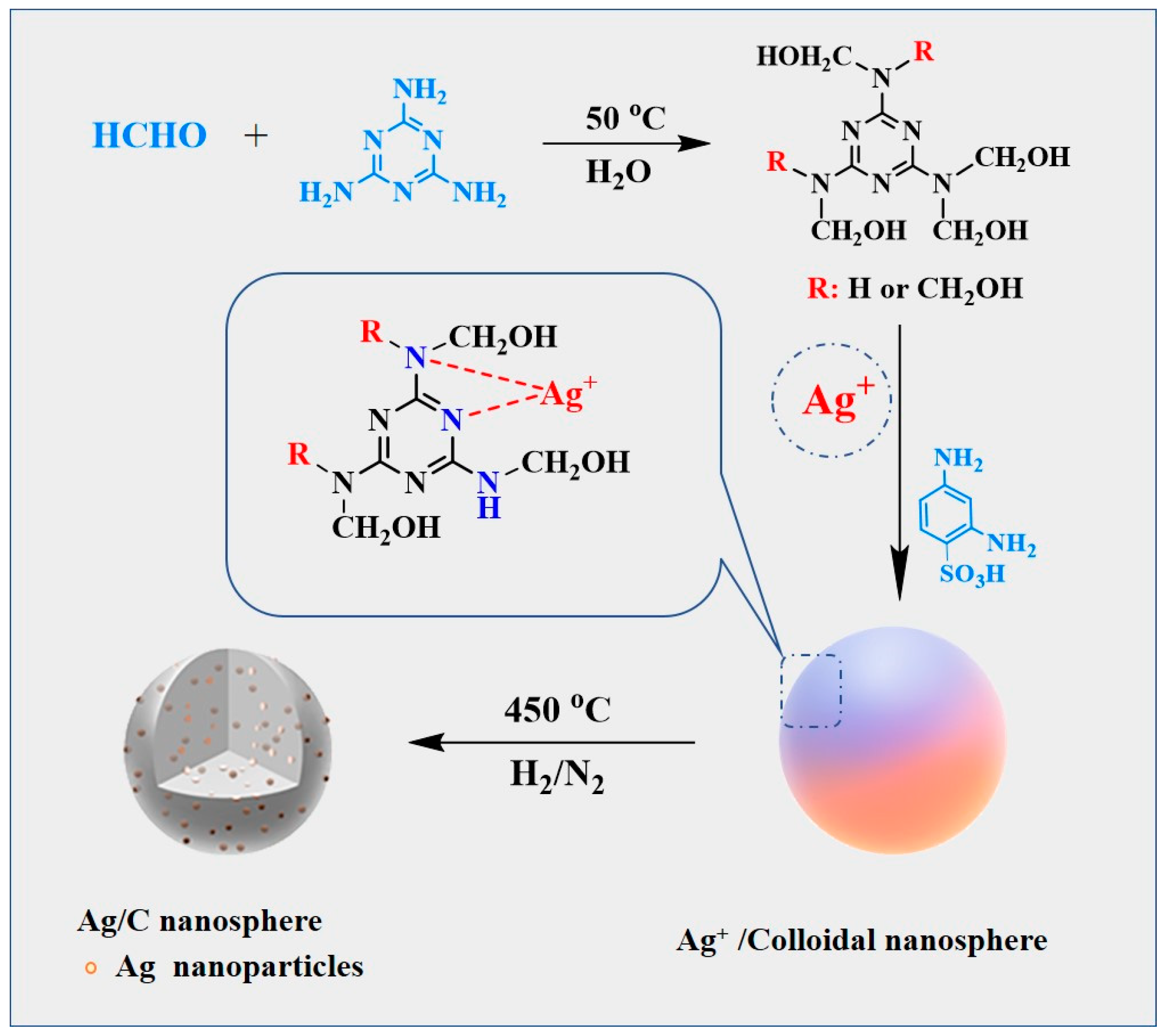
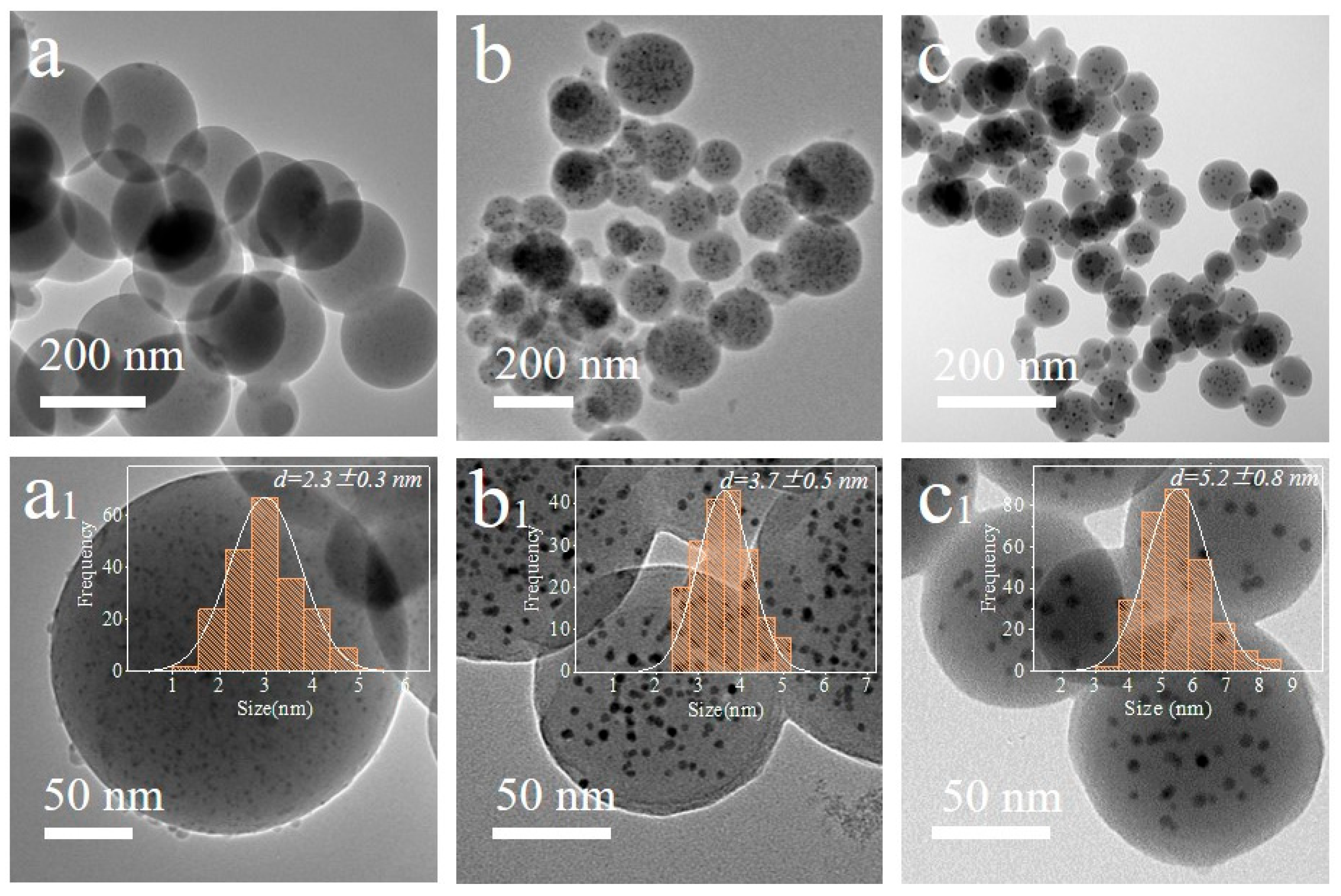
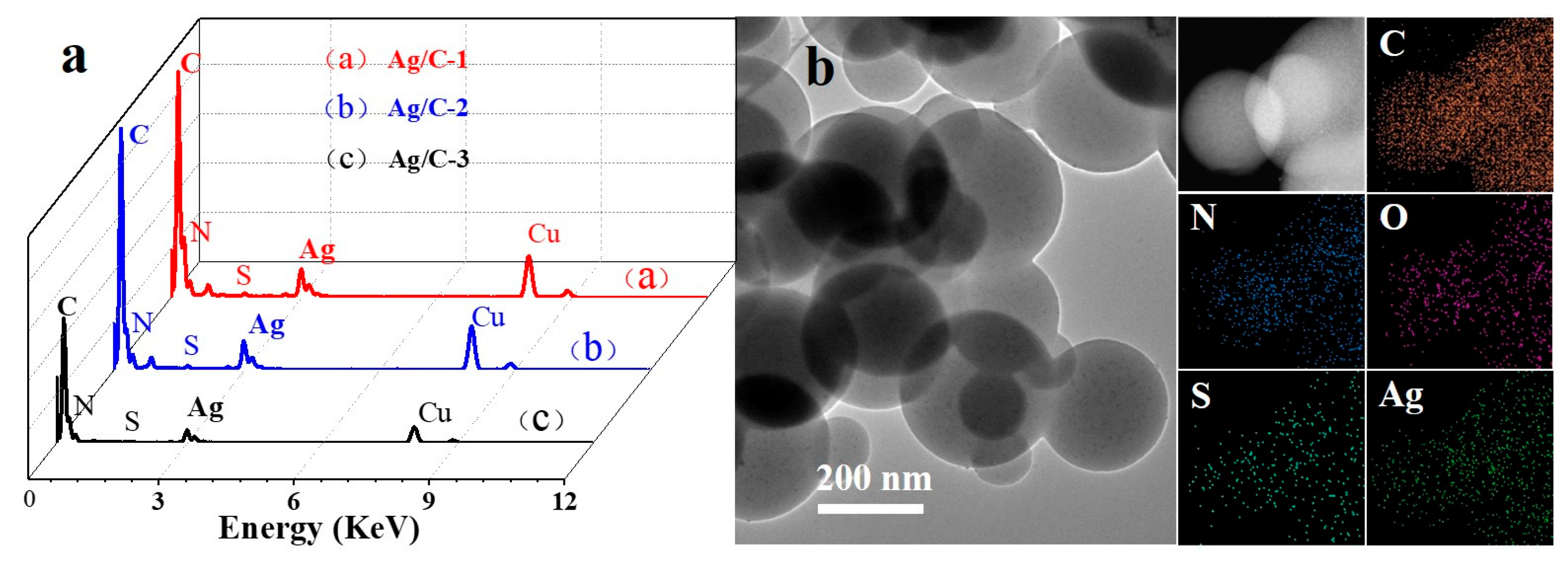
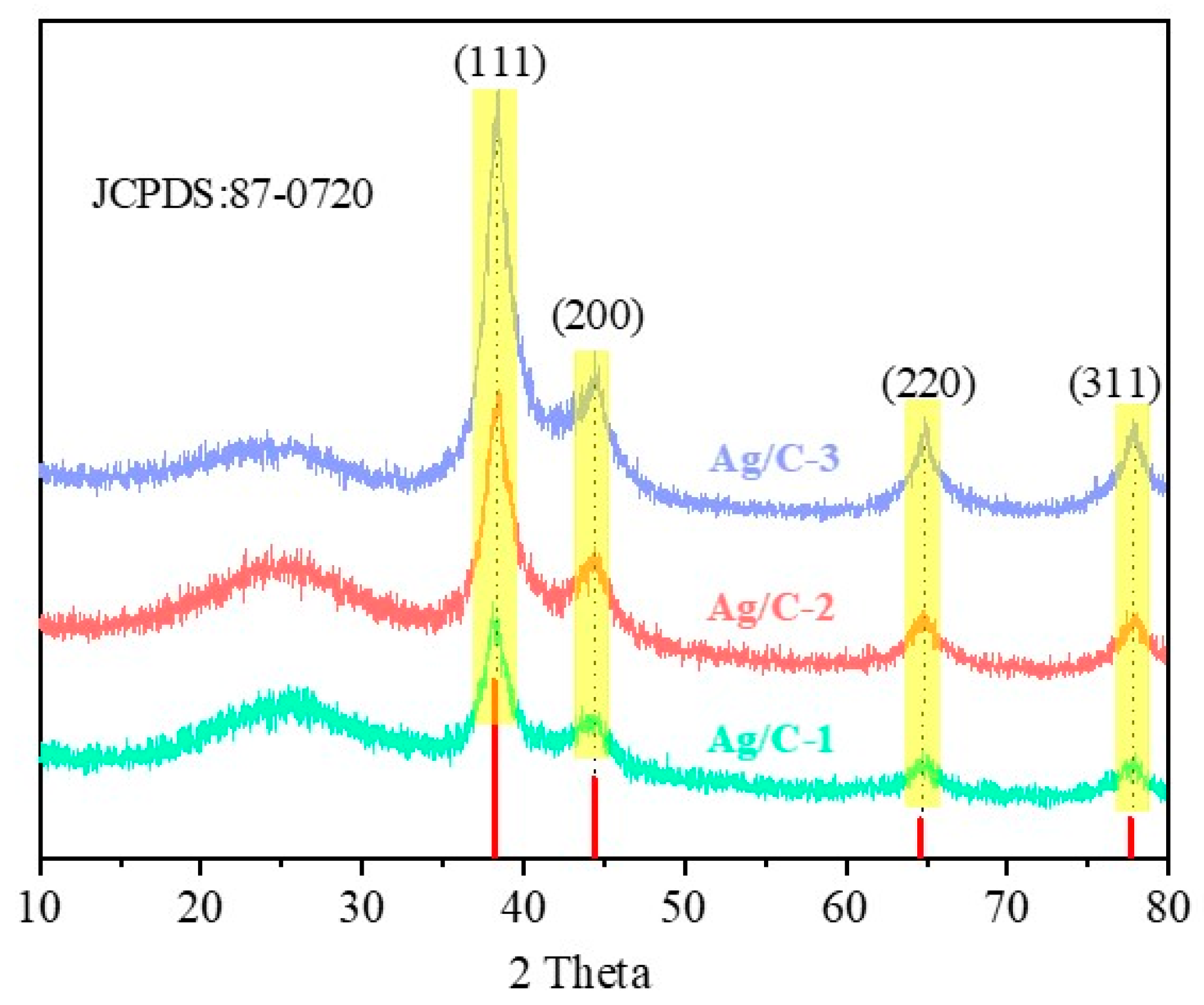

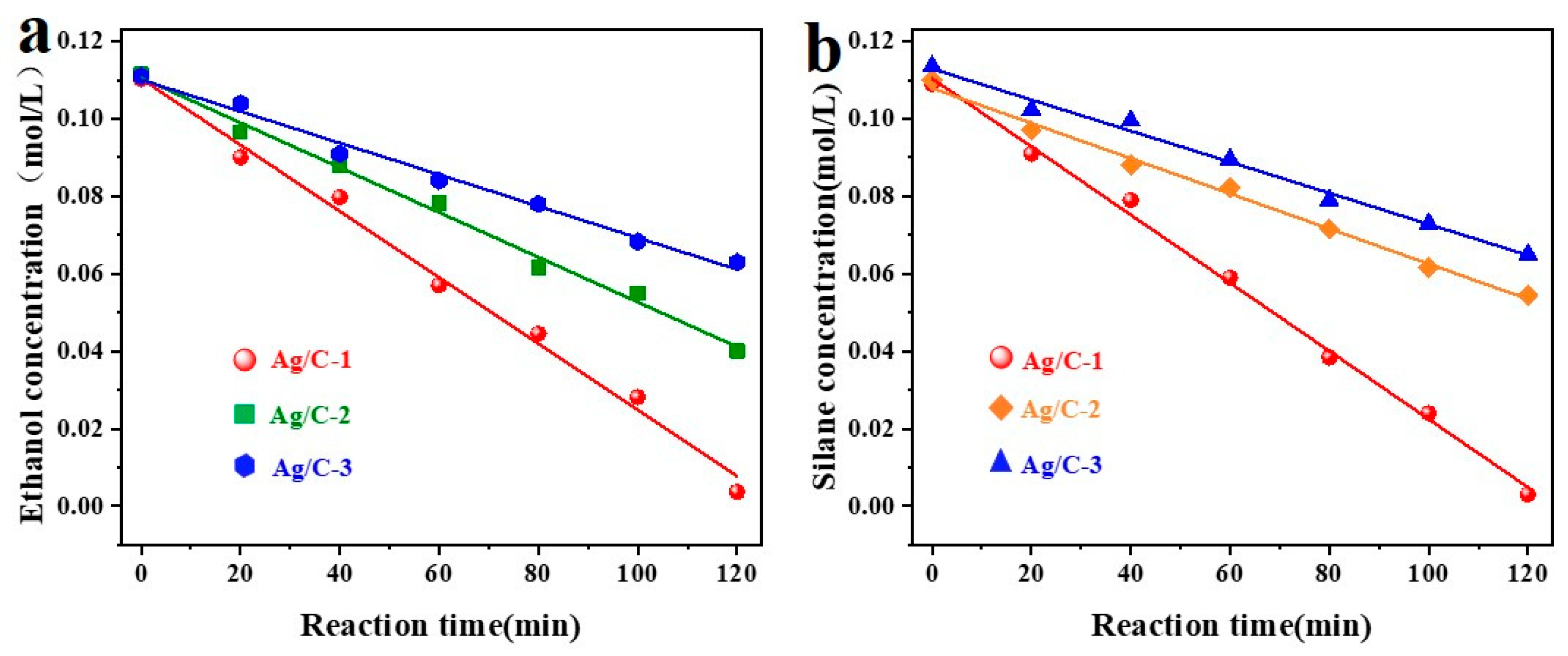
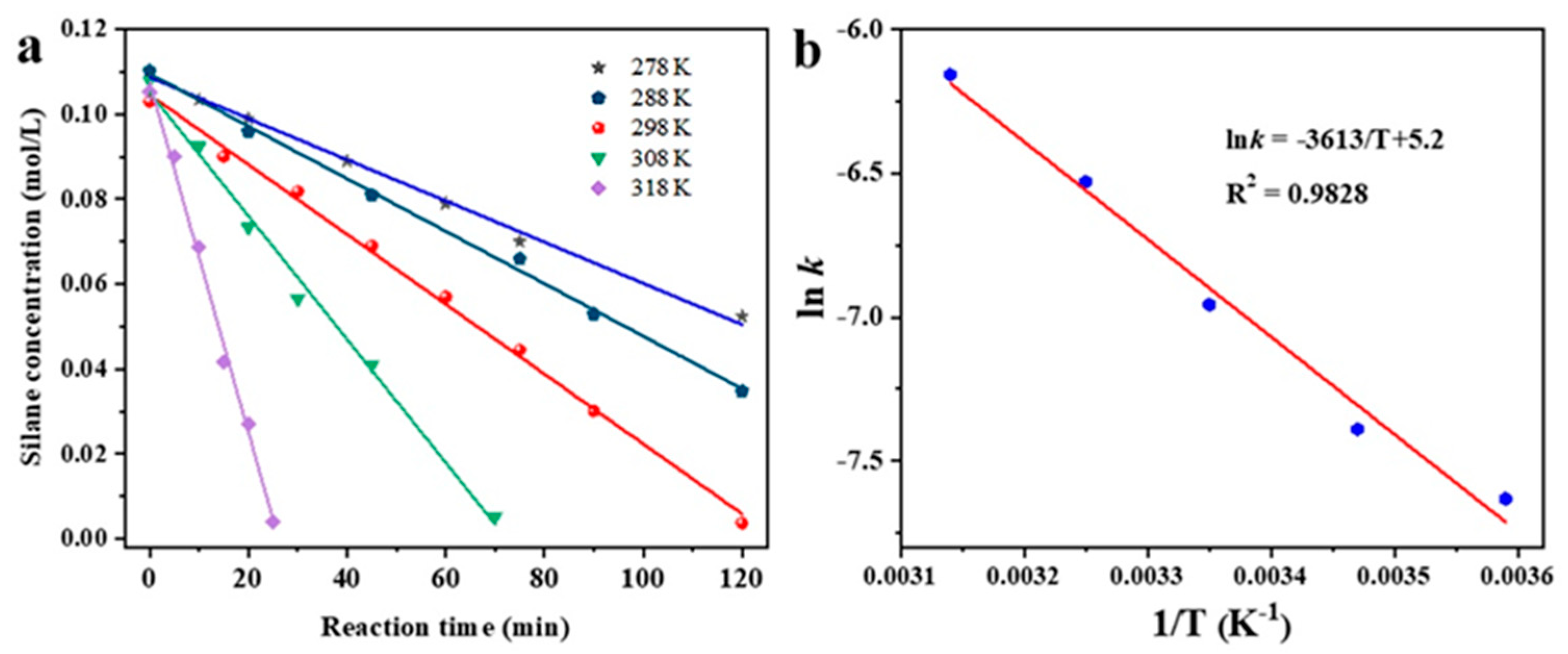

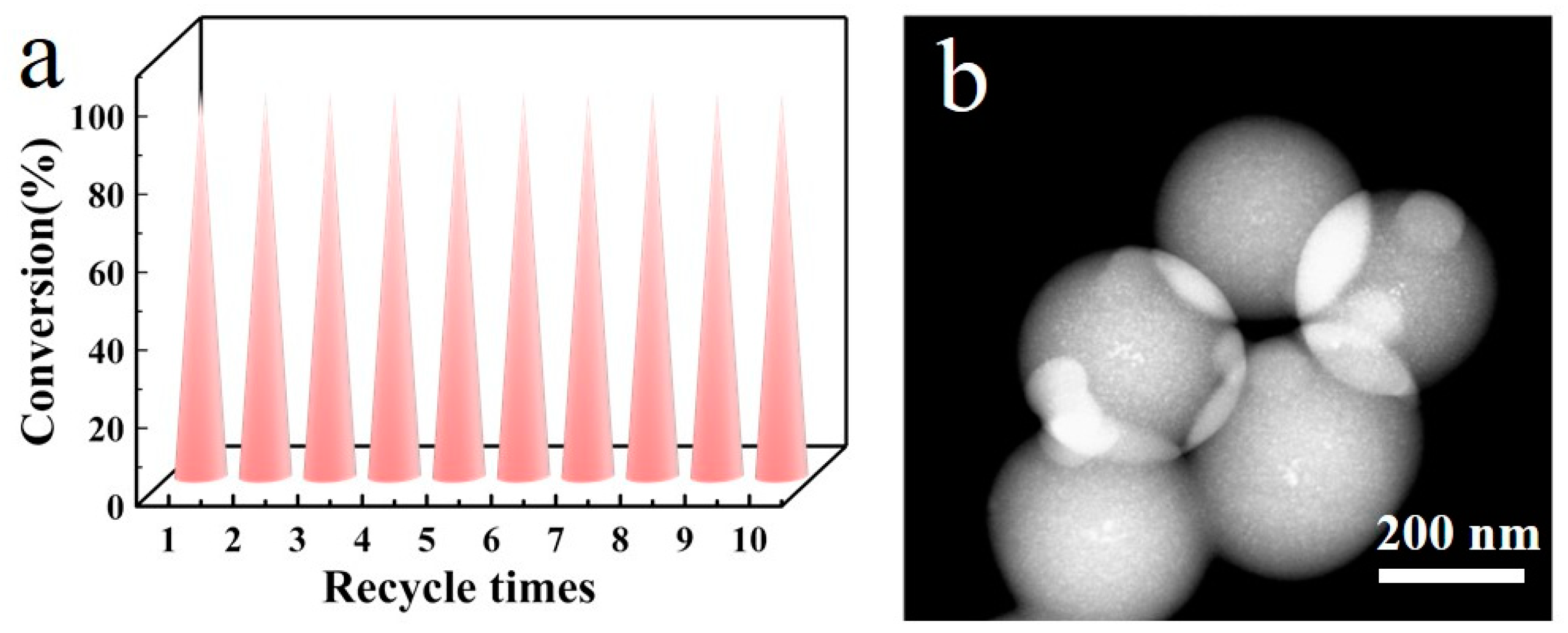

| Entry a | Catalyst | Time (min) | Selectivity b (%) | Conversion b (%) | TOF c |
|---|---|---|---|---|---|
| 1 | None | 160 | 0 | 0 | - |
| 2 | C | 160 | 0 | 1.4 | - |
| 3 | AgNO3 | 160 | 98.2 | 13.7 | - |
| 4 | Ag/C-1 | 120 | 99.3 | 99.1 | 6.37 |
| 5 | Ag/C-2 | 135 | 99.2 | 98.2 | 4.97 |
| 6 | Ag/C-3 | 160 | 99 | 98.9 | 3.18 |
| Entry a | Silane | Alcohol | Temperature (°C) | Time (h) | Selectivity b (%) | Conversion b (%) | TOF c |
|---|---|---|---|---|---|---|---|
| 1 | PhMe2SiH | Methanol | 25 | 1 | 99.1 | 99.2 | 9.37 |
| 2 | Ph2MeSiH | Methanol | 25 | 1.1 | 98.8 | 98.5 | 9.10 |
| 3 | Et3SiH | Methanol | 25 | 1.5 | 99.2 | 99.3 | 7.33 |
| 4 | PhMe2SiH | Ethanol | 25 | 2 | 98.9 | 98.7 | 6.37 |
| 5 | Ph2MeSiH | Ethanol | 25 | 2.5 | 99.1 | 98.8 | 2.43 |
| 6 | Et3SiH | Ethanol | 25 | 7 | 98.5 | 96.5 | 1.05 |
| 7 | PhMe2SiH | n-Butanol | 50 | 5 | 99.5 | 99.5 | 1.57 |
| 8 | Ph2MeSiH | n-Butanol | 50 | 6 | 99.3 | 98.3 | 1.22 |
| 9 | Et3SiH | Benzyl alcohol | 80 | 10 | 83.7 | 91.7 | 0.77 |
| 10 | Ph2MeSiH | Benzyl alcohol | 80 | 10 | 2 | 5.1 | 0 |
Disclaimer/Publisher’s Note: The statements, opinions and data contained in all publications are solely those of the individual author(s) and contributor(s) and not of MDPI and/or the editor(s). MDPI and/or the editor(s) disclaim responsibility for any injury to people or property resulting from any ideas, methods, instructions or products referred to in the content. |
© 2024 by the authors. Licensee MDPI, Basel, Switzerland. This article is an open access article distributed under the terms and conditions of the Creative Commons Attribution (CC BY) license (https://creativecommons.org/licenses/by/4.0/).
Share and Cite
Liu, M.; Huang, H.; An, C.; Feng, X.; Wang, Z. Facile Synthesis of Ultra-Small Silver Nanoparticles Stabilized on Carbon Nanospheres for the Etherification of Silanes. Nanomaterials 2024, 14, 1095. https://doi.org/10.3390/nano14131095
Liu M, Huang H, An C, Feng X, Wang Z. Facile Synthesis of Ultra-Small Silver Nanoparticles Stabilized on Carbon Nanospheres for the Etherification of Silanes. Nanomaterials. 2024; 14(13):1095. https://doi.org/10.3390/nano14131095
Chicago/Turabian StyleLiu, Minghui, He Huang, Changwei An, Xue Feng, and Zijing Wang. 2024. "Facile Synthesis of Ultra-Small Silver Nanoparticles Stabilized on Carbon Nanospheres for the Etherification of Silanes" Nanomaterials 14, no. 13: 1095. https://doi.org/10.3390/nano14131095





